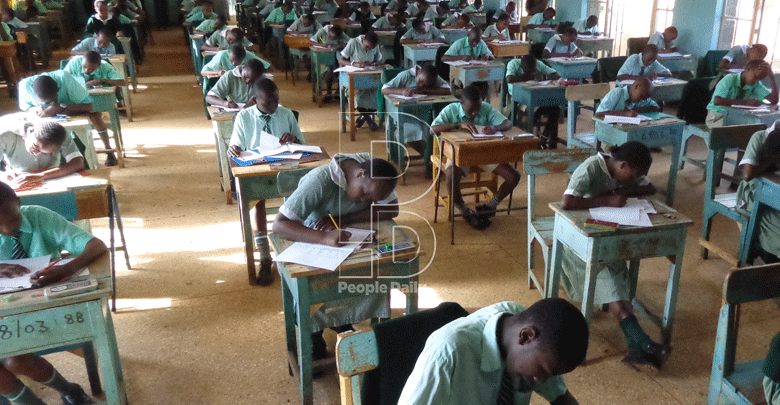Shock of mass failure in student key assessment

Mercy Mwai and Bernard Gitau
First assessment of Grade Four learners and Standard Eight pupils reveals mass failure. The statistics released yesterday show serious levels of unpreparedness for the more than one million candidates set to sit their Standard Eight examinations next month.
The learning assessment, conducted in October after schools resumed after the long Covid-19 break and meant to gauge their preparedness for the final examination, registered mass failures in virtually all the subjects.
National Learning Assessment report, released by the Kenya National Examination Council (KNEC), showed most candidates failed to attain the minimum benchmark of 50 per cent in most of the subjects assessed.
The results come weeks to the KCPE examinations. The 1.1 million Standard Eight pupils are expected to sit the Kenya Certificate of Primary Education (KCPE) examination between March 22-24.
“One of the major findings of the study is that the majority of Class 8 learners are still performing below average.
This is evidenced by the substantial proportions of learners who did not attain the minimum benchmark (50 per cent) in most of the subjects assessed,” reads the report.
It further revealed poor performances among learners in subject specific content or skill areas.
The assessment, done to establish Grade 4 learners’ performance levels in languages, Mathematics, Environmental Activities and Science and Technology, reveals there was a decrease in the proportion of learners meeting and exceeding expectation in specific skills or content areas in English Language compared to their performance in Monitoring Learner Progress (MLP).
“From the foregoing, it is observable that the majority of the Grade 4 learners are yet to attain minimum proficiency levels in subject specific content areas/skills, with substantial proportions performing below expectation,” reads the report.
The assessment was conducted to inform teachers and other education stakeholders on possible learning loss or gaps, which may have been occasioned by lack of face-to-face learning and limited access to remote learning during the 10-month Covid-19 period when learners were out of school. The assessment was geared towards providing reliable data upon which decisions on appropriate interventions can be anchored.
Term One assessments
It was also intended to act as the end of Term 1 examinations or assessments since at the time of closure in march last year, majority of schools had not done their end of term examinations.
It was also intended to track learner achievement and provide schools with a uniform standardised tool to assess the achievements.
The poor performance is a clear indication the virtual learning conducted during the time learners were out of schools did not yield positive results.
Learners also showed low proficiency in reading for meaning.
“Low proficiency levels in Writing/Composition continue to be reported, pointing to low facility in creativity and communication.
The performance gap between different sub-groups such as boys and counties and school category is yet to be bridged,” states the report.
Schools countrywide were closed in mid-March last year after the first case of Covid-19 was reported in the country.
The government then announced gradual reopening in October last year, starting with Grades 4, Class 8 and Form 4. The rest of the classes resumed learning last month.
Among class eight pupils, Kenyan Sign Language Composition, Mathematics, KSL (Language,) English Composition and Kiswahili Composition (Insha) were the worst performed as they only managed to attain averages of 25.94 per cent, 34.54 per cent, 36.18 per cent, 39.90 per cent, and 45.19 per cent, respectively.
The study shows that Kenya Sign Language registered the lowest mean at 36.9, followed by English and Kiswahili at 44.73 and 46. 64, respectively. Low achievement in Writing is also recorded in the report.
It further points to lack of creativity and communication skills among Class Eight learners, with low learning outcomes being observed in English, Kiswahili and Kenyan Sign Language compositions.
“Similarly, significant proportions of pupils did not attain the minimum proficiency level in other skills and content areas of the assessed subjects,” says the report.
It also shows that in Mathematics, significant learning gaps were noted in measurement, averages, percentages, proportions and ratios and money, with 69.01 per cent, 68.57 per cent, 68.26 per cent and 66.96 per cent of the learners, respectively, not attaining minimum benchmark.
On language skills, the study raises concern on the substantial percentages of pupils not attaining minimum proficiency after low proficiency levels were reported in English, especially in the application of knowledge of word categories and grammatical categories and Reading for meaning.
Low proficiency levels were also observed in Kiswahili, where 61.01 per cent of Class Eight learners did not attain minimum proficiency level in Reading Comprehension (Ufahamu), adding that gaps were also established in Grammar (Sarufi) where 57.41 per cent of learners did not attain minimum proficiency.
In Science, learning gaps were noted in areas of Soil and Properties of Matter, where 50.18 per cent and 50.82 per cent of the learners did not attain the minimum benchmark.
In Social Studies, substantial proportions of learners did not attain the minimum benchmark in map work (Political Development and Systems), Resources and Economic Activities and Political Development and Systems at 66 per cent, 63.54 per cent and 57.09 per cent, respectively.
In CRE, learning gaps were established in the New Testament, with a significant proportion (45.71 per cent) of the learners not attaining the minimum proficiency level.











